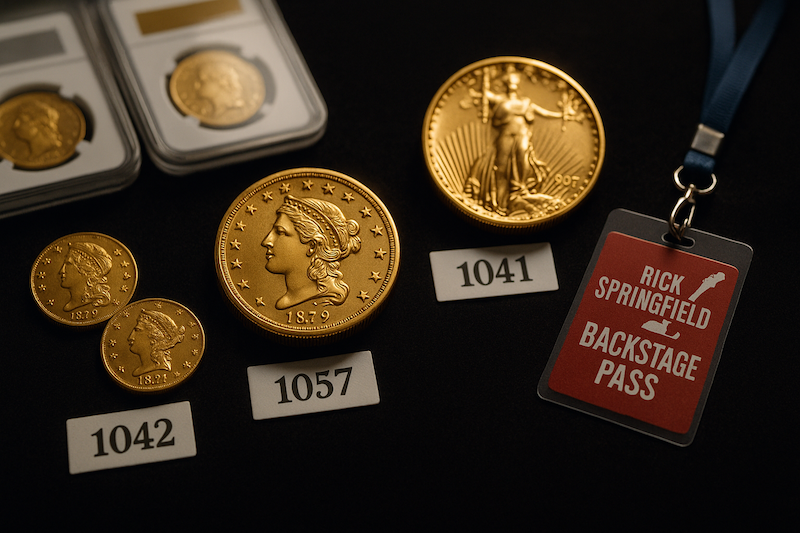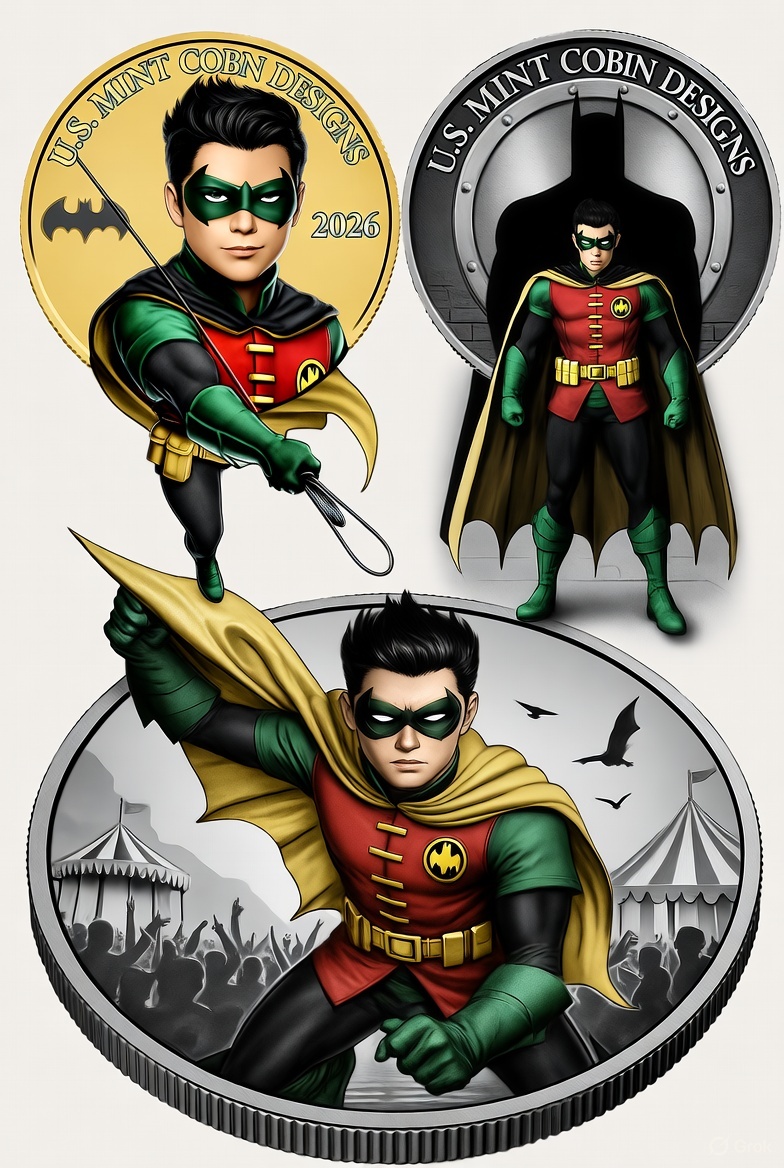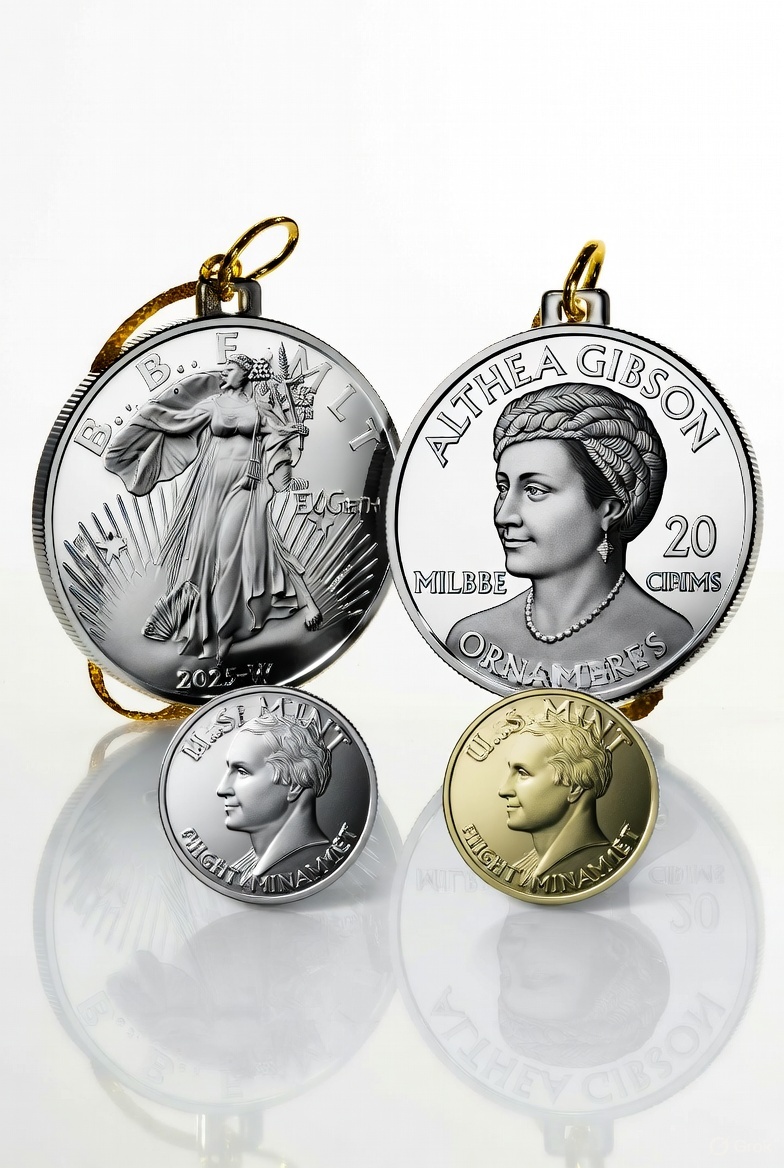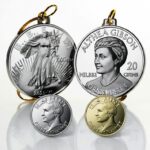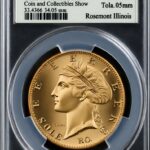If you collect classic U.S. gold—or advise clients who do—circle your calendar. The Rick Springfield gold coin collection is heading to Stack’s Bowers’ Summer 2025 Global Showcase Auction, a star-powered sale packed with trophy-grade pieces like an 1879 Flowing Hair $4 Stella (PR65) and a 1907 High Relief Saint-Gaudens double eagle (MS-67+). Beyond the celebrity headline, this is a tightly curated cabinet of about three dozen coins that checks key boxes: condition rarity, visual appeal, and third-party validation (PCGS/NGC, CAC, and CMQ). Bidding runs August 25–30 and September 2–5 at the firm’s Griffin Studios in Costa Mesa, with lot viewing slated to begin August 27.
TL;DR
- Stack’s Bowers will auction the Rick Springfield gold coin collection Aug. 25–30 and Sept. 2–5, 2025 (lot viewing opens Aug. 27).
- Headliners include an 1879 Flowing Hair $4 Stella (PR65 PCGS) and a 1907 High Relief Saint-Gaudens $20 (MS-67+ PCGS).
- Many pieces are CAC and/or CMQ approved—signals of premium quality within grade.
- Market context is favorable: recent Stack’s Bowers events notched strong prices; 2024 set records, and early-2025 auctions were robust.
Why the Rick Springfield gold coin collection matters now
Celebrity provenance captures attention, but the numismatic substance here stands on its own—early quarter eagles, three-dollar gold, Indian and Liberty gold types, and marquee patterns and double eagles in elite condition. Stack’s Bowers underscores the focus on quality: “a small but select group of numismatic treasures,” in President Brian Kendrella’s words. Springfield himself frames the intent succinctly: he wanted “some of the best coins…in the best condition.”
The sale coincides with the ANA World’s Fair of Money timeframe, when high-end buyers are active and consignors often place rare material. Stack’s Bowers is an Event Auctioneer Partner to the ANA for this summer showcase—a placement that typically amplifies bidder participation and visibility.
Market context: demand for top-tier U.S. gold
- Stack’s Bowers reported a historic $275.6 million in auction sales for 2024; early 2025 U.S. Showcase events continued to see strong demand and record prices.
- Independent coverage likewise points to energetic bidding across categories in 2025, with notable results at major shows.
Takeaway: In the current market, fresh, premium-quality coins with strong third-party validation tend to outperform average material—a dynamic this collection is built to tap.
Highlights, history, and benchmarks
1879 Flowing Hair $4 Stella, Proof-65 (PCGS)
The $4 Stella is the quintessential U.S. pattern series, a short-lived proposal (1879–1880) to facilitate international trade via metric-based denominations. The Flowing Hair design (Barber) remains the most widely collected subtype. PCGS CoinFacts documents the type’s history and auction records, while Stack’s Bowers notes a PR65 example realizing $384,000 in 2018—illustrating the price elasticity for superb pieces. Recent PCGS Price Guide indications around the mid-$200Ks to upper-$200Ks for PR65 provide a sense of range, with obvious premiums for eye appeal, CAM/DCAM contrast, and CAC/CMQ.
Why collectors care
- Short series, iconic status in U.S. patterns
- Low surviving population in true Gem Proof
- Readily verified provenance and grading data via PCGS/NGC
1907 Saint-Gaudens Double Eagle, High Relief, Flat Rim, MS-67+ (PCGS)
Widely regarded as the pinnacle of American coin design, the 1907 High Relief double eagle reflects President Theodore Roosevelt’s “Renaissance of American Coinage.” The Flat Rim variety is scarcer at the finest levels; the PCGS population report shows extremely tight populations in MS-67 and above. Price-guide signals and past APRs for MS-67 High Reliefs suggest very strong six-figure levels, with plus grades and exceptional eye appeal nudging the needle higher.
Why collectors care
- Design history and artistic significance
- Condition rarity at MS-67 and above
- Strong, transparent market comps and populations
Early quarter eagles and classic gold types
Springfield’s cabinet also features early $2.50s—a segment prized for scarcity and type importance:
- 1808 Capped Bust Left Quarter Eagle (one-year type)—mintage ~2,710; long recognized as a key rarity.
- 1825 & 1833 Capped Head Left Quarter Eagles—low mintages, thin Mint State populations; the 1833 is particularly elusive in Gem.
These pieces complement later Indian and Liberty issues and high-grade eagles and double eagles, creating a condensed “gold type” narrative centered on rarity and quality. (
Third-party signals: PCGS/NGC grading, CAC approval, and the CMQ sticker
For high-stakes coins, collectors and investors look for layered verification:
- PCGS & NGC provide standardized grading, population data, and auction records that let market participants triangulate scarcity and value.
- CAC approval (“green bean” / “gold bean”) indicates a coin is solid or premium for the grade—often correlating with higher liquidity and stronger prices realized.
- CMQ (Collectible Market Qualified), launched by David Hall and Stack’s Bowers, adds a further “premium within the grade” screen, with CMQ and CMQ-X tiers assessed for quality and eye appeal.
Expert view: “In a crowded marketplace, independent quality signals are the great separator,” notes David Hall in CMQ’s launch coverage—an observation borne out by record prices for CMQ/CMQ-X coins in Rarities Night sessions.
Does celebrity provenance add value?
Sometimes. Sales linked to “name” cabinets—think Eric P. Newman or D. Brent Pogue—often realized premiums attributable to impeccable quality and storied pedigrees. CoinWeek documented a “Newman premium” effect when his coins crossed the block, and the Pogue auctions set headline records with stellar average lot values. Still, not every celebrity collection guarantees a premium; substance (rarity, grade, eye appeal) drives sustainable demand.
Balanced take: Expect attention from outside the hobby because Springfield is a Grammy-winning entertainer, and Stack’s Bowers has even sweetened the top lot with two VIP concert passes and a backstage meet-and-greet—a clever experiential kicker. But serious bidders will still anchor decisions on numismatic fundamentals and third-party signals.
Key lots at a glance
| Highlight | Why it matters | Data points / benchmarks |
|---|---|---|
| 1879 Flowing Hair $4 Stella, PR65 (PCGS, CAC, CMQ) | Trophy-level U.S. pattern; short series; Gem Proof rarity | PCGS Price Guide for PR65 ~mid-$200Ks to high-$200Ks; SB 2018 Gem brought $384,000 (market dependent) |
| 1907 Saint-Gaudens $20 High Relief, Flat Rim, MS-67+ (PCGS) | Iconic design; top-pop scarcity; strong collector base | PCGS pop report shows very few at MS-67 and higher; guide indications in the strong six figures for MS-67 (varies by eye appeal) |
| 1808 Capped Bust Left $2.50 | One-year type; tiny mintage; type-set essential | Mintage ~2,710; long-recognized rarity |
| 1833 Capped Head Left $2.50, MS-66 (PCGS) | Thin MS population; top-end eye appeal in this date | “Very rare date,” with ~10–12 Mint State pieces known historically; MS-66 is elite |
| 1908 Indian Eagle, Motto, MS-68 | Top-grade type gold with broad demand | Past APRs and references show MS-68 as a special tier within the date; thin census at the top |
Note: All values and ranges are illustrative and market-dependent; bidders should consult current catalogs and price guides before bidding.
How to bid on the Rick Springfield gold coin collection like a pro
- Study the catalog & preview lots. The auction preview and lot listing are live; arrange lot viewing starting August 27 if possible, in person or via virtual consultations.
- Verify certifications. Cross-check PCGS/NGC cert numbers, CAC verification, and CMQ status (both offer searchable databases).
- Anchor your bids. Use recent APRs and price-guide ranges as a starting point, then adjust for originality, color, strike, and eye appeal. PCGS and NGC maintain deep APR archives.
- Weigh provenance premiums. Collections with recognizable names can command extra competition; decide your ceiling ahead of time, especially on marquee lots.
- Plan for post-auction costs. Factor buyer’s premium, taxes, shipping, and insurance.
Risks and considerations
- Market volatility: Rare coins are illiquid compared with exchange-traded assets; prices can swing between sales. Consult multiple sources (PCGS/NGC, Greysheet, auction archives).
- Grade sensitivity: One grade step (or a CAC/CMQ designation) can materially change value; buy the coin, not just the label.
- Opportunity cost: Iconic coins can tie up significant capital; diversification across types and price tiers can mitigate concentration risk. (General best practice; see market overviews for 2024–2025.)
What industry voices are saying
- “We are thrilled to bring these incredible coins to market,” said Stack’s Bowers President Brian Kendrella, highlighting the quality focus and the collection’s crossover appeal.
- Springfield notes he always wanted the “best coins…in the best condition,” a philosophy reflected in CAC and CMQ approvals across key lots.
- NGC spotlighted the consignment as well, noting a dozen NGC-certified rarities among the offerings.
FAQs
When and where is the auction?
August 25–30 and September 2–5, 2025, at Stack’s Bowers’ Griffin Studios in Costa Mesa, California; lot viewing begins August 27.
Is this tied to the ANA World’s Fair of Money?
Yes. Stack’s Bowers stages its Global Showcase as an Event Auctioneer Partner to the ANA’s summer show, which draws deep bidder pools.
What are CAC and CMQ? Do they affect value?
CAC verifies that a certified coin is solid or premium for its grade; CMQ (and CMQ-X) denotes coins that meet additional, stringent quality standards set by David Hall and Stack’s Bowers—both can correlate with higher liquidity and stronger prices.
How valuable are the headliners?
Market-dependent, but references show Gem Stellas trading in the mid- to upper-$200Ks historically, with standout examples higher; High Relief Saints in MS-67 are firmly in six figures with population-driven scarcity. Always check current catalog estimates and APRs before bidding.
Is there a special perk for the top lot?
Yes—two VIP concert passes and a backstage meet-and-greet with Rick Springfield for the leading buyer, per Stack’s Bowers’ announcement.
Conclusion: A focused chance to buy blue-chip U.S. gold
The Rick Springfield gold coin collection is exactly the kind of event that crystallizes broader market themes: a seller with a connoisseur’s eye, an auction platform that targets peak bidder engagement, and lots that blend rarity, condition, and top-tier third-party endorsements. Whether you collect for passion, advise clients, or build inventory, approach with a plan—study the data, verify the certifications, and price the coin, not the hype. If your playbook is ready, this late-August showcase could be a smart place to deploy capital for long-term numismatic quality.
